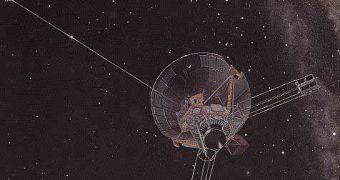In the early 1970s, NASA launched two spacecraft into space, namely Pioneer 10 and Pioneer 11, in missions involving the study of the solar system. However, a decade later both started experiencing strange trajectories, drifting off course by several hundred thousand kilometers. As the two spacecraft are moving away from the Sun, their traveling speed decreases in relation to the solar system by several fractions due to gravitational pull. Albeit, it seems that the Sun exerted a slightly powerful pull than that expected.
Until now, explanations for this baffling effect, known in popular culture as the Pioneer anomaly, ranged all the way from a possible modification in the law of gravity to radiation pressure, observational error, leaks, clock acceleration or unaccounted gravitational forces produced by the Kuiper belt or even dark matter.
According to Slava Turyshev from NASA's Jet Propulsion Laboratory, in the case of Pioneer 11 thermal effects are to blame, at least for part of the weird trajectories experienced by this probe. In the last two years, Turyshev and his colleagues have analyzed the telemetry and tracking data from the reconstructed recording devices used during the Pioneer 11 mission. Results of the analysis show that Pioneer 11 suffered a uneven thermal distribution across its surface, emitting more heat in some areas than in others. Furthermore, the heat emission is powerful enough to account for the 28 to 36 percent deviation in the probe's course, detected at a distance of 3,750 million kilometers or 25 astronomical units from Earth.
Turyshev reckons that it is possible the probe suffered surface degrading because of interstellar dust and ultraviolet radiation, which changed the optical properties of the shielding. This ultimately resulted in more heat being radiated in some areas than in others, determining a change in trajectory. Results are expected to be obtained in less than five months, in order to confirm the theory.

 14 DAY TRIAL //
14 DAY TRIAL //